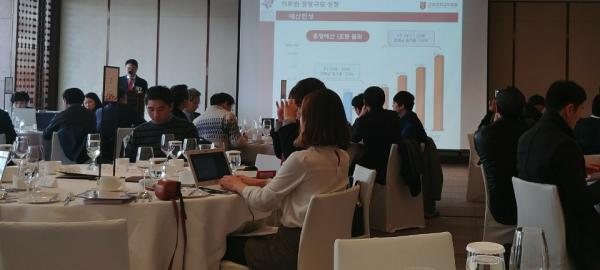Korea University Medical Center said Thursday it would shift its growth strategy from increasing the number of beds to investing in the bio-health business for the future.
The KUMC’s two hospitals – Korea University Anam Hospital and Korea University Guro Hospital – were designated as research-based hospitals in 2016. Last year, the KUMC won the state project to lead the national development of precision medicine.

The KUMC is also reviewing to change its name to Korea University Medicine to better serve the international needs in the future, according to the hospital.
“We’re are seriously considering changing our brand to KU Medicine,” said Park Jong-woong, head of the medical planning division at the KUMC, in a news conference at the Westin Chosun Seoul, Wednesday.
Changing the English name of the hospital is to use bio-heath research as a growth engine in the global medicine market.
Park, who is also a professor of orthopedic surgery at the KUMC, said the name “Medical Center” gives an impression that the hospital focuses only on patient treatments.
“If we use the word, ‘health system,’ it feels like a group of hospitals or a cluster of hospital services. In other countries, hospitals create brands such as Duke Medicine, U-Penn Medicine, and Harvard Medicine,” Park said. “The KUMC also plans to revise its name that integrates the concept of education, research, and the hospital system.”
Park went on to say that university hospitals’ current profitmaking from patient care will face a limitation. “The KUMC will not try hard to raise the number of beds. Instead, we will seek profits through bio-health business and use the profits to invest in research, creating a virtuous cycle,” he said.
The hospital will apply the same goal to the Advanced Integrated Medical Center, being built on the site of 20,000 pyeong (66,115 square meters) since September last year.
“People might expect that we could enlarge the number of beds of Korea University Anam Hospital, which has 1,500 beds because our land site is 20,000 pyeong. But we will raise the bed number only by 150. The rest area will be allocated for bio-health research, better service for existing patients, and building a refreshing environment,” Park said.
The KUMC said its moves could be regarded as “risks” among local hospitals, but the hospital was going in the right direction, in keeping with the global trends.
“There is not much room for a hospital to raise profits through patient care because patient care is standardized,” said Oh Sang-cheol, head of research and education division at the KUMC. “The bio-health industry is an important part of the fourth industrial revolution. The KUMC has 400-500 full-time professors. Ideas based on their clinical experiences will be limitless.”
“We’re not challenging a model that has a low probability of success. Such model already exists abroad. It is a model we must succeed in Korea, too,” Oh added.

